What if your organization’s hidden performance issues and untapped talent potential could be revealed through a single strategic shift in your evaluation process?
This question keeps senior HR leaders awake at night—and for good reason. Traditional performance metrics often fail to capture crucial interpersonal dynamics, leadership blind spots, and collaboration challenges that directly impact your bottom line.
The solution lies in 360 degree performance feedback —a comprehensive evaluation approach that gathers insights from everyone interacting with an employee. By collecting perspectives from managers, peers, direct reports, and self-assessments, you gain the complete picture needed to make truly informed talent decisions.
When implemented effectively, this method doesn’t just improve performance metrics—it transforms your culture, cultivates authentic leadership, and aligns individual growth with organizational success. The result is a workplace where potential is recognized, blind spots are addressed, and teams naturally excel.

What is a 360 Degree Performance Feedback?
360 degree performance feedback represents a holistic approach to evaluating an individual’s performance by gathering feedback from various sources within the organization.
Unlike traditional feedback systems, which typically involve input solely from supervisors, 360 degree feedback includes insights from peers, direct reports, and even self-assessment. This multifaceted perspective provides a more comprehensive view of an employee’s strengths and areas for improvement.
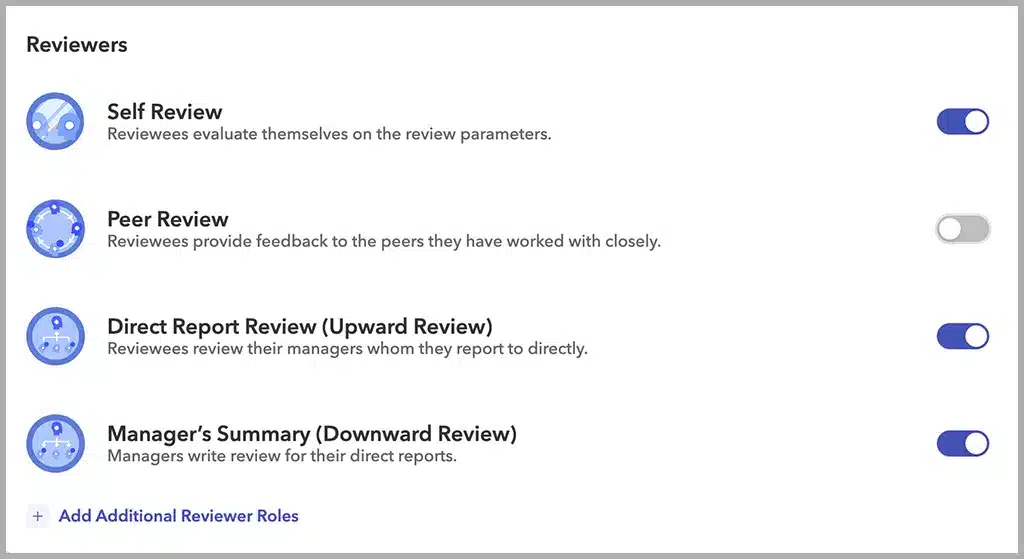
Here’s a quick look at how 360 degree feedback differs from traditional feedback systems.
| Aspect of Feedback | Traditional Feedback | 360 degree Feedback |
| Perspective Source | Supervisor-centric | Multidimensional (Supervisors, Peers, Direct Reports, Self) |
| Assessment Focus | Job-related tasks and responsibilities | Broad set of competencies including teamwork and leadership |
| Purpose | Performance appraisal and salary decisions | Individual and team development, continuous learning |
| Insights Bias | Susceptible to biases | Reduced impact of individual biases |
| Self-Awareness | Limited understanding of impact on others | Enhanced self-awareness, revealing blind spots |
| Team Collaboration | Primarily individual focus | Fosters teamwork and collective responsibility |
| Developmental Focus | Past performance | Future-oriented, aligns with personal and team goals |
| Objective Insights | Relies on one person’s viewpoint | Collects input from multiple perspectives |
| Link to Organizational Goals | May lack clear connection | Direct link between individual and organizational objectives |
Benefits of 360 degree Performance Feedback
Enhanced Self-Awareness for Employees
360 degree feedback fosters self-awareness by offering individuals a nuanced understanding of how their actions impact those around them. This heightened self-awareness enables employees to refine their behavior, leading to personal and professional growth.
Improved Teamwork and Collaboration
By incorporating useful feedback from various team members, 360 degree feedback promotes a culture of collaboration. Employees gain insights into their communication styles and teamwork, fostering an environment where diverse talents can coalesce for greater overall team efficiency.
Identification of Blind Spots and Areas for Development
The inclusion of multiple perspectives helps uncover blind spots an individual might have about their own performance. This identification of blind spots serves as a catalyst for targeted development initiatives, ensuring continuous improvement.
Aligning Individual Goals with Organizational Objectives
360 degree feedback facilitates the alignment of individual goals with broader organizational objectives. By understanding how their contributions impact the larger picture, employees can tailor their efforts to drive organizational success.

Now that we have established the importance of a robust 360 degree performance feedback system, let’s dive into three easy steps with which you can implement it in your organization.
3 Steps of Designing an Effective 360 Degree Performance Feedback System
Crafting a robust 360 degree performance feedback system requires a strategic approach that encompasses three fundamental steps. These steps are essential for creating a feedback mechanism that not only captures a comprehensive view of an individual’s performance but also fosters a culture of continuous improvement and development within the organization.
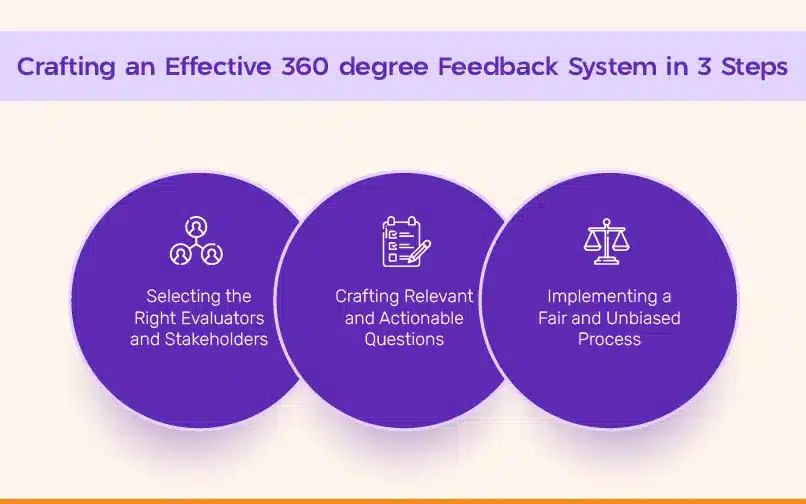
Selecting the Right Evaluators and Stakeholders
Selecting the right evaluators and stakeholders is a pivotal step in designing a robust 360 degree performance feedback system. The success of this system hinges on the diversity of perspectives and the depth of insights gathered from various organizational roles.
Typically, a comprehensive 360 degree evaluation has four types of reviewers: The employees themselves, their peers, their managers, and their direct reports.
Peoplebox.ai allows you to select from the four primary reviewer roles and effortlessly incorporate customized additional roles tailored to your organization.
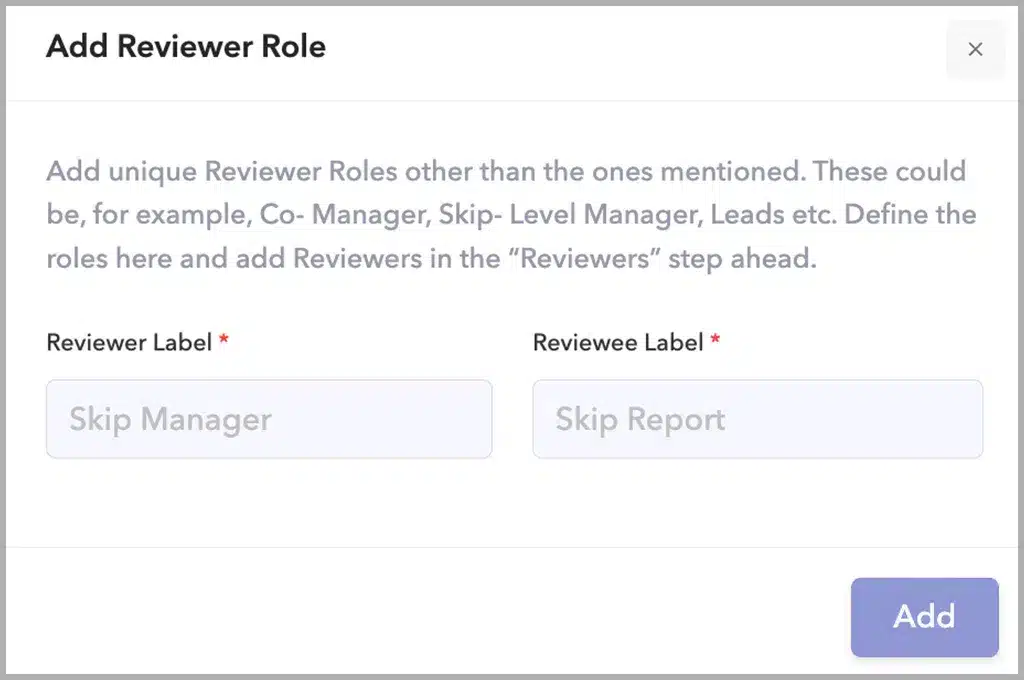
Self-Evaluation
Self-evaluation plays a pivotal role in the 360 degree feedback process. Individuals possess an intimate knowledge of their own strengths, weaknesses, and areas for improvement. Incorporating self-assessment allows employees to actively participate in their professional development and fosters a sense of ownership.
Best Practices:
Encourage honest feedback: Create a framework that encourages individuals to critically evaluate their performance without the fear of judgment.
Align with organizational goals: Guide employees to relate their self-assessment to the broader objectives of the organization.
Facilitate goal-setting: Use self-evaluation as an opportunity for individuals to set personal and professional goals aligned with organizational expectations.
When it comes to self-evaluations, achieving an effective review can be challenging, as individuals tend to either exhibit bias or be overly critical. To assist your team in navigating self-evaluations effectively, we have compiled a list of 60+ self-evaluation examples. Share these examples with your team for valuable insights.
Peer Feedback
Peer evaluations provide a unique perspective on an individual’s performance, capturing insights that may not be apparent through traditional hierarchical channels. Peers observe day-to-day interactions, collaboration skills, and teamwork, offering valuable input on interpersonal dynamics.
Best Practices:
Ensure diversity in peer selection: Include peers from various departments, teams, or projects to gather a broad spectrum of perspectives.
Emphasize constructive feedback: Encourage peers to provide specific examples of observed behaviors, both positive and areas for improvement.
Maintain anonymity: Create a confidential environment that allows peers to share feedback openly without fear of repercussions.
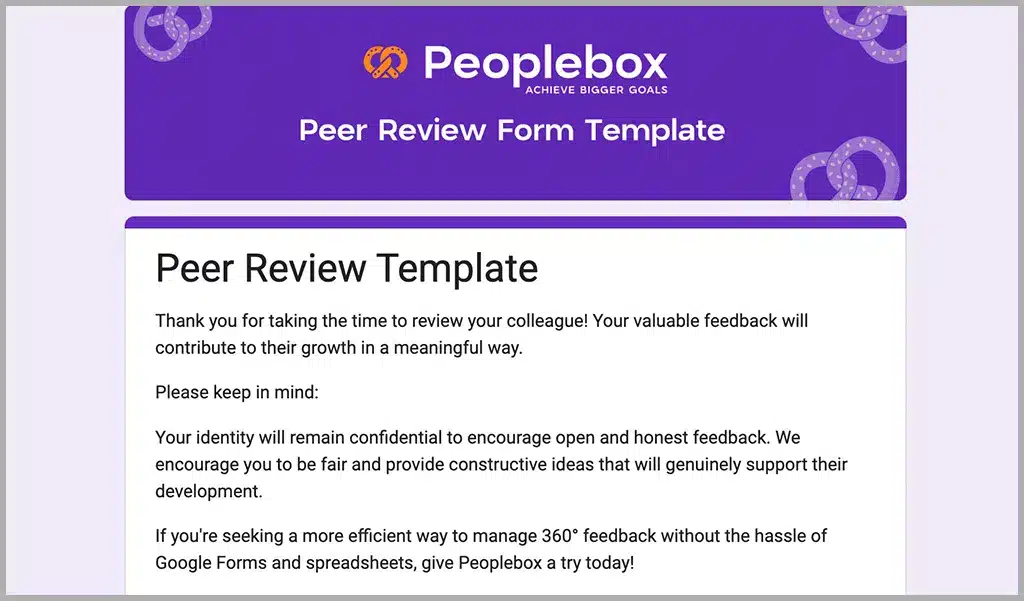
However, we must address the elephant in the room— peer reviews can be biased. To mitigate that, share these 70 peer review examples that your team can use today to provide unbiased and helpful feedback.
However, we must address the elephant in the room— peer reviews can be biased. To mitigate that, share these 70 peer review examples that your team can use today to provide unbiased and helpful feedback.
Manager Evaluation
Managers play a crucial role in assessing an individual’s job performance, goal achievement, and alignment with organizational expectations. Their vantage point offers insights into leadership skills, strategic contributions, and overall professional conduct.
Best Practices:
Set clear expectations: Provide managers with a framework that aligns with organizational goals and clearly outlines the areas to evaluate.
Consider multi-level management input: In organizations with multi-level management structures, collect feedback from direct supervisors as well as higher-level managers for a comprehensive view.
Emphasize developmental feedback: Encourage managers to provide feedback that facilitates professional growth and aligns with the individual’s career trajectory.
As a manager, providing constructive feedback is an integral part of the process. However, it can be challenging. To assist your managers, consider sharing our curated list of 45 non-offensive negative feedback examples.
Direct Report Evaluation
Direct reports offer a unique perspective on leadership effectiveness, communication, and the impact of management decisions on team dynamics. Their input is invaluable for managers seeking to enhance their leadership skills and create a positive work environment.
Best Practices:
Foster a culture of open communication: Ensure direct reports feel comfortable providing feedback by promoting a culture of open dialogue and trust.
Encourage balanced feedback: Direct reports should provide feedback on both strengths and areas for improvement, fostering a constructive and balanced assessment.
Use feedback for leadership development: Leverage direct report feedback as a tool for managerial growth and leadership development, emphasizing actionable insights.
Crafting Relevant and Actionable Questions for 360 Degree Feedback Review
Up next, crafting the right questions.
The effectiveness of a 360 degree feedback system is heavily reliant on the caliber of questions posed in the assessment. Crafting questions that are not only relevant to an individual’s role but also actionable for employee development is a nuanced process.
Why does it matter?
Precision in Assessment:
Crafting questions that are specific and targeted ensures a precise assessment of the individual’s performance. Vague or generic questions may yield ambiguous responses, hindering the actionable value of the feedback.
ProTip: Recognize that different roles demand different skills and competencies. Craft questions that directly align with the unique aspects of each role within the organization.
Alignment with Organizational Objectives:
Questions should be carefully aligned with the competencies, skills, and behaviors critical to an individual’s role and the broader organizational goals. This alignment ensures that the feedback contributes directly to enhancing job performance and achieving strategic objectives.
Encouraging Constructive Feedback:
Well-crafted questions encourage respondents to provide constructive feedback. Clear and insightful questions prompt evaluators to share specific examples, facilitating a more comprehensive understanding of the individual’s strengths and areas for improvement.
ProTip: Encourage evaluators to provide specific examples of observed behaviors. This helps individuals receiving feedback understand the context and take targeted actions for improvement.
Balancing Qualitative and Quantitative Insights:
Effective questions strike a balance between qualitative and quantitative aspects. While qualitative responses offer depth and context, quantitative data provides measurable insights, allowing for a holistic evaluation of performance.
ProTip: Work with HR and leadership to identify the key competencies critical to success within the organization. Craft questions that directly address these competencies. Selecting the right competencies for performance reviews can be a daunting task with the myriad of options available. That’s why we’ve done the heavy lifting for you. Our curated list of performance review competency examples is a comprehensive resource that simplifies the process of choosing the most relevant competencies for your evaluation process.
In a nutshell, crafting the right 360 degree performance review questions is crucial for fostering a thorough and meaningful evaluation process. It is a process that transcends mere inquiry, aiming to extract insights that not only inform but also inspire positive change.

Implementing a Fair and Unbiased Process
The third step in designing an effective 360 degree performance feedback system is to ensure that the process is fair and unbiased. Achieving fairness is crucial for fostering trust among employees and obtaining accurate insights that contribute to meaningful professional development.

Here’s how you can implement a fair 360 degree evaluation process:
Establish Clear Evaluation Criteria:
Begin by establishing transparent and well-defined evaluation criteria that align with the goals and values of the organization. Clear criteria provide a foundation for fair assessments and help evaluators focus on specific competencies, mitigating the risk of subjective judgments.
Select Diverse Evaluators:
To enhance fairness, carefully select evaluators from diverse backgrounds and positions within the organization. Including perspectives from various levels and departments ensures a balanced and comprehensive assessment. This diversity helps counteract potential biases that may arise from a singular viewpoint.
Provide Training for Evaluators:
Offer training sessions to evaluators to ensure they understand the purpose of the 360 degree feedback process and are equipped to provide constructive and objective assessments. Training should emphasize the importance of fair evaluations, avoiding personal biases, and focusing on observable behaviors and competencies.
Monitor and Address Potential Biases:
Regularly monitor the feedback process for any signs of bias and address them promptly. This may involve conducting periodic audits, reviewing evaluation results, and addressing discrepancies. Creating a feedback loop for continuous improvement helps maintain the integrity of the system.

Before proceeding, it’s essential to emphasize that diversity and inclusion are more than mere checkboxes. To genuinely thrive in today’s dynamic workplace, you must fully embrace diversity. If you’re unsure how, we’ve outlined five strategies to enhance diversity and inclusion in the workplace. Give it a read.
Overcoming Challenges in 360 Degree Performance Feedback
Implementing a 360 degree performance feedback system brings about transformative benefits, but it is not without its challenges. Addressing these challenges head-on is crucial to ensuring the success and effectiveness of the feedback process. Let’s explore three key challenges and strategies to overcome them.
Addressing Resistance from Employees or Management
Implementing a 360 degree feedback system may encounter resistance from both employees and management. Employees might be apprehensive about receiving feedback from multiple sources, fearing it could impact their relationships or career progression. On the other hand, management may resist the change due to concerns about added complexity or skepticism about the benefits.
Strategies to Overcome Resistance:
Transparent Communication: Openly communicate the purpose and benefits of 360 degree feedback. Address concerns proactively, emphasizing the developmental nature of the process and its positive impact on individual and team growth.
Educational Initiatives: Conduct workshops or training sessions to educate employees and management about the value of diverse feedback. Provide case studies or testimonials showcasing successful implementations to alleviate concerns.
Pilot Programs: Initiate small-scale pilot programs to demonstrate the effectiveness of 360 degree feedback. Collect feedback from participants to address concerns and refine the process before full-scale implementation.
Dealing with the Fear of Negative Consequences
Fear of negative consequences, such as damaged relationships or repercussions on performance evaluations, can hinder the honesty and openness crucial for effective feedback. Employees may be reluctant to provide candid input if they perceive potential harm to their professional standing.
Strategies to Overcome the Fear of Negative Consequences:
Emphasize Development: Reinforce the developmental focus of 360 degree feedback. Communicate that the primary goal is improvement, not punishment. Highlight success stories where constructive feedback led to positive outcomes.
Feedback Training: Provide training on giving and receiving feedback. Equip employees with the skills to deliver constructive criticism and receive it positively, fostering a culture where feedback is seen as a tool for growth rather than criticism.

Continuous Improvement of the Feedback System
The effectiveness of a 360 degree feedback system can diminish over time without continuous improvement. Without periodic assessments and adjustments, the system may become outdated or fail to address emerging organizational needs.
Strategies for Continuous Improvement:
Regular Evaluations: Periodically assess the feedback system’s effectiveness through surveys or focus groups. Gather input from participants to identify areas for improvement and refine the process accordingly.
Feedback Loops: Establish feedback loops within the organization to gather insights on the impact of feedback. Use this information to make informed adjustments to the feedback process, ensuring its relevance and resonance.
Technology Integration: Explore innovative tools and technologies to enhance the efficiency and user-friendliness of the feedback system. Integrating advanced analytics can provide valuable insights into trends and areas needing attention.
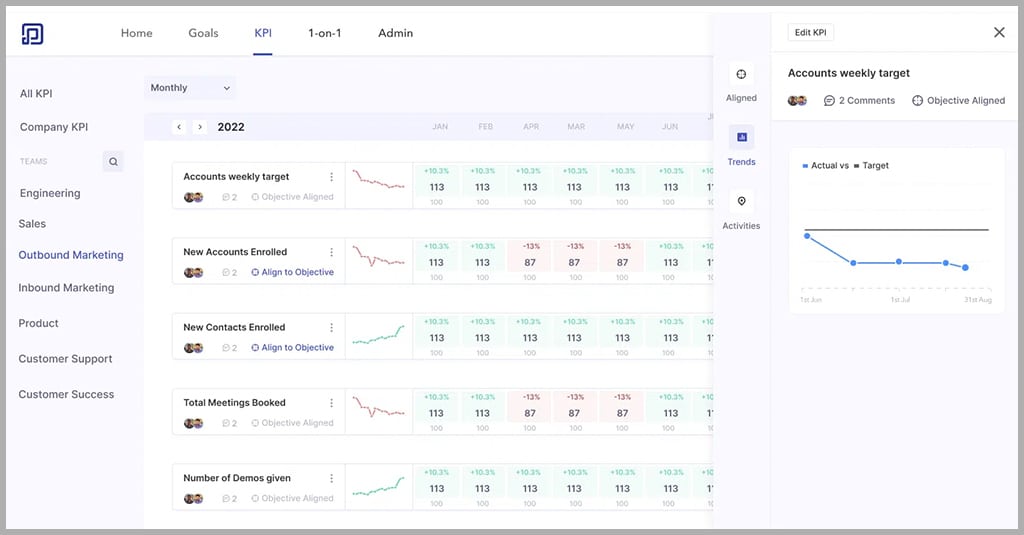
Run 360 Degree Performance Feedback with Peoplebox.ai
360 degree performance feedback has become a comprehensive and holistic approach to evaluating an individual’s contributions within an organization. However, navigating the complexities of 360 degree reviews can be challenging without the right tools and strategies in place.
Enter Peoplebox.ai – an employee performance management platform designed to revolutionize the way organizations approach employee reviews. By offering a suite of tools, including 1:1 meetings, check-ins, surveys, and reviews, Peoplebox.ai simplifies the entire process, making it more efficient and impactful than ever before.
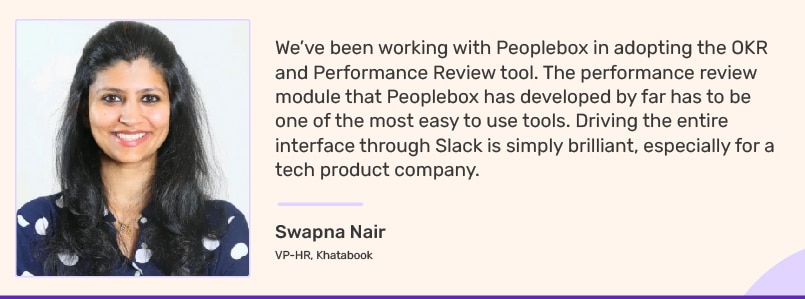
It empowers HR professionals to effortlessly navigate the complexities of 360-degree performance feedback, cultivating a culture of growth and development. Its seamless integration with tools like Slack, Teams, Jira, Asana, Google Sheets, and more, underscores a dedication to delivering real-time updates and encouraging continuous engagement.
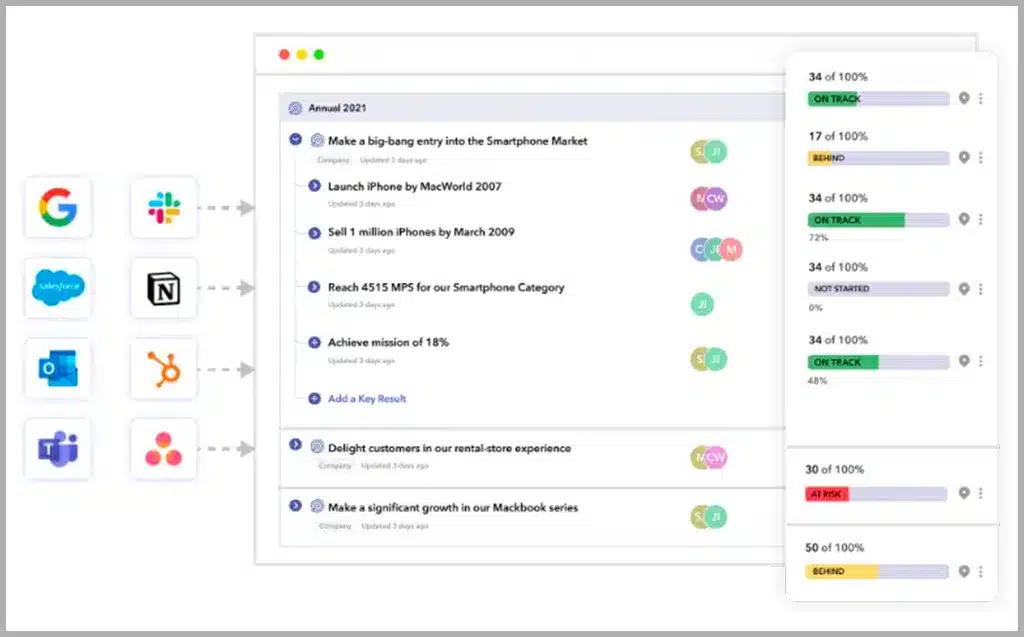
Ready to revolutionize your approach to employee reviews? Talk to us today and discover how Peoplebox.ai can elevate your organization’s performance management processes.









